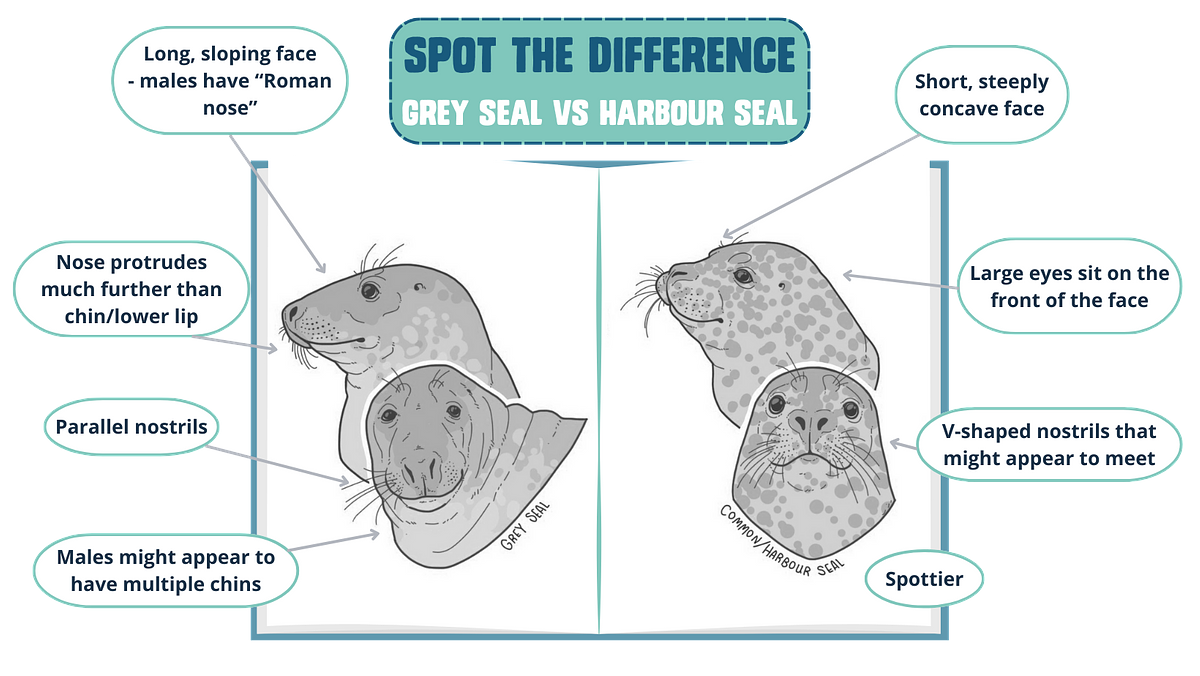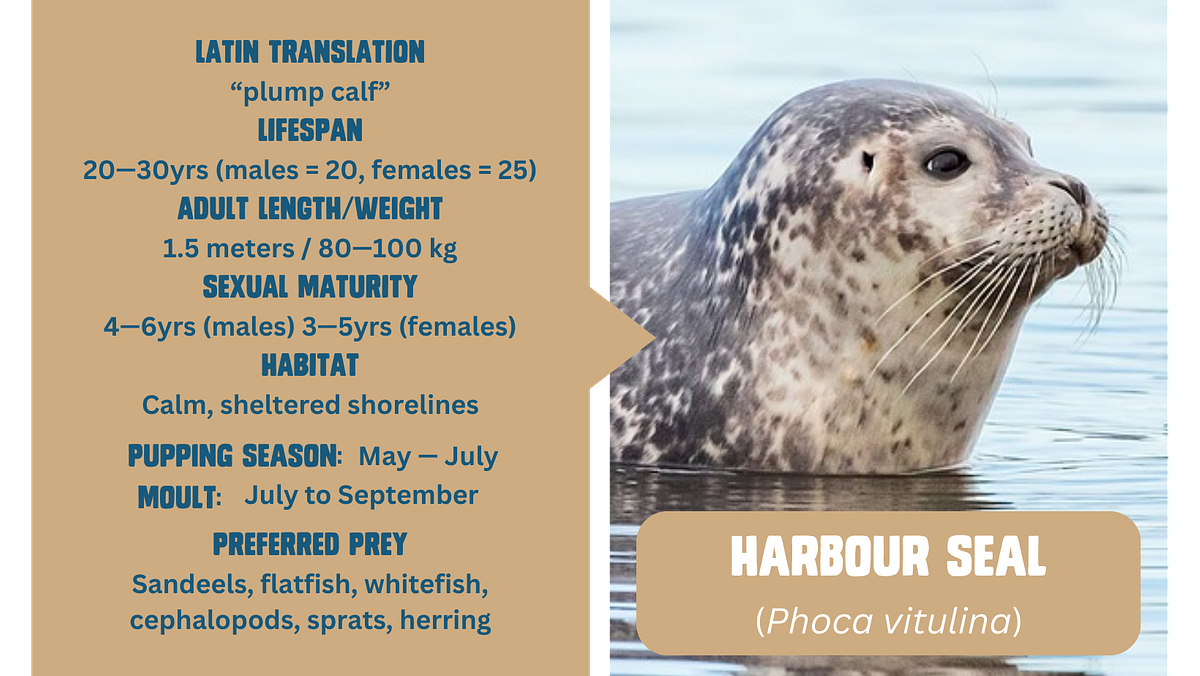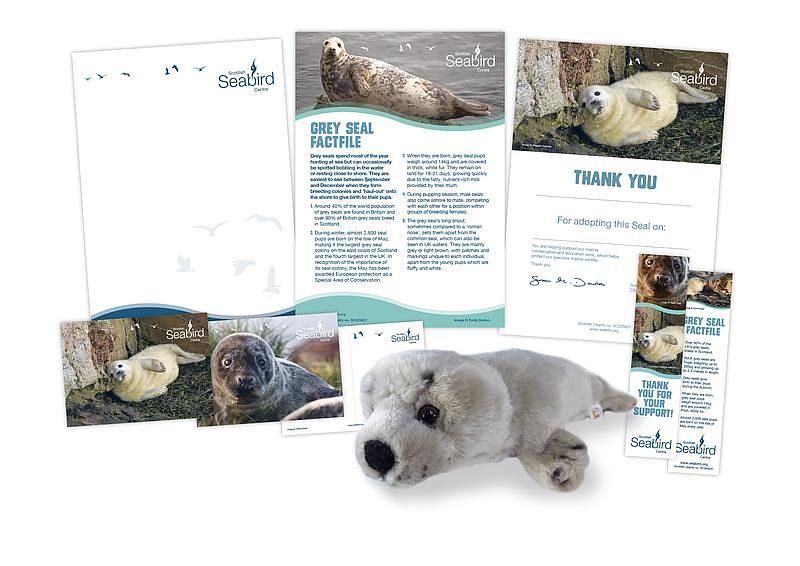_David_Steel_2021.png)
Spotting the Difference: Seal Species in Scotland
By Emma Marriott, Conservation Assistant
Scotland has more seals living in its waters than anywhere in Europe. They’re a common sight along the coast, which is perhaps why there are so many myths and tales surrounding them, extending throughout the country’s long history. Despite this, their secretive lives beneath the sea mean that many of us don’t know much about them. Let’s take a short dive into their curious world and get to know these enigmatic marine creatures a bit better.
The first thing to know is that the seals we see breeding here are Phocids or “true seals”. They differ from their close relatives—the “eared seals” such as sealions—as they’re more adapted to life beneath the waves. They can dive deeper and for longer than eared seals, but when it comes to moving on land they’re rather less elegant!

Only two species of seal are found breeding in Scotland. The first is the cute and not-so-common “Common” or Harbour seal (Phoca vitulina). The second is the slightly larger, more populous and vaguely grumpy looking Grey seal (Halichoerus grypus). The latter are hardy, favouring the rough seascapes of exposed coastlines where their preferred places of rest are wave-battered islands or gnarled, rocky shores. On the other hand, if you spot a seal lounging in tranquil waters or on a secluded, sandy beach then it’s more likely that you’re seeing a Harbour seal. This is by no means a foolproof method of telling them apart, however, so there are a few other things that you should know about them…
- Grey seals sing. Okay, so they’re unlikely to reach #1 in any mainstream music charts and I use the word “sing” loosely, but take a winter wander along a lonely, wind-washed coastal clifftop and you might just hear an undulating, ghostly lament rising like foam off the white-capped waves. As females jostle and haul themselves up the shore to breed and birth their pups, they sometimes produce these eerie wails that might have helped inspire the mythology behind Scottish “selkies”.
- Harbour seal pups are born from May to July and tend to give birth in calm, shallow water.
- Grey seals give birth on land in Autumn and select breeding sites that they will return to year upon year.
- Harbour seal pups don’t have white fur. If you see a seal pup looking snug in a white fur coat, it’s probably a Grey seal. This is because Harbour seal pups shed their white fur in their mother's womb.
- Grey seals are larger and heavier. With adult males reaching up to 2 meters in length and a whopping 300kg, Grey seals make Harbour seals seem small—even though the latter, at 100kg, can weigh as much as a washing machine.

- Harbour seals have a steeper forehead, a blunter face and nostrils that might appear to meet in a ‘V’ shape. Some people think they look a bit more dog-like than Grey seals, which have parallel nostrils, a long, sloping “roman nose” and eyes that sit more on the side of their face. Grey seals are sometimes known as “Horseheads” for this reason.
- Grey seals moult between December and April. Blood is diverted to the outer skin and peripheries so that the hair cells have a sufficient supply of nutrients to create new fur. As a result, they’ll lose body heat much more quickly in the water than at other time of the year. This means you’ll be more likely to see them out of the water at this time. Harbour seals, on the other hand, moult from July to September.
- Harbour seals are spottier. Their sleek coat is more dappled looking. Female grey seals are more blotchy than spotty, with dark backs and pale undersides, whereas males are usually darker all over.
It can be difficult to identify a Grey from a Harbour seal based on only one of these features, but when used in combination we can be fairly confident in telling them apart. Now that we’ve looked at them side by side, let’s explore each species individually in a bit more detail...
Grey Seal (Halichoerus grypus) – aka “haaf fish”, “ron mor” & “horsehead”
.png)
Occurring solely in the Baltic, Barents and North Atlantic Seas, there are thought to be somewhere in the region of 400,000 individuals worldwide. Around 40% of these live around the UK, with 90% of UK grey seals choosing Scotland to breed. They inhabit exposed islands and shorelines and will travel upwards of 62 miles (100km) from their haul out site to feed on their preferred prey items of sandeels, whitefish and flatfish.
Females reach sexual maturity at 3—6 years old and give birth in autumn in large groups, selecting breeding sites that they will return to year upon year. Pups are born with a covering of fluffy white fur that is moulted over the course of 3 weeks or so. They will remain at the breeding site during this time, as their white coats are not waterproof, and their mothers will hardly eat anything until the pups are weaned 3—4 weeks after birth.

On the contrary, pups might triple their weight before weaning, as they feed 5—6 times a day for as long as 10 minutes at a time. A typical pup will weigh 45—50kg when it is weaned. This is equivalent to two fully packed large suitcases! They need these fat reserves to sustain them until they learn to hunt for themselves, which can take several weeks, as they will no longer be fed by their mothers once they are able to swim.
Mothers do not always stay with their pups. Though they remain with them for the first few days following birth (a critical time for mother-pup bonding that gives the mother time to become familiar with her pup’s unique cries and smell), they may move into the water when the pups are not feeding. However, they will remain close to shore and come onto land to feed their pups until they are ready to be weaned.
.png)
Harbour (Common) Seal (Phoca vitulina vitulina) – “tang fish”, “ron cumanta” & “Black Seal”

Five subspecies of harbour seal exist, but the European subspecies resides in the North Pacific and North Atlantic Seas (including the North Sea) and consists of around 100,000 individuals. 30% of this number live in the waters around the UK. Of these, about 80% live around Scotland. They inhabit calm, sheltered shorelines and will travel 25—30 miles (40—50km) from their haul out site to feed on sandeels, flatfish, whitefish, cephalopods, sprats and herring.
Females sexually mature at 3—5 years old. They prefer to give birth in solitude, away from busy haul out sites and usually in shallow water or, occasionally, on land. However, although they tend to be more solitary than other seal species, they do form large colonies during the breeding season. Pups are born from May to July. Their fluffy white coat is shed in the womb, so they are born sleek and can swim within their first few hours or even minutes. Pups can suckle in the water or out of it and are fed on very rich milk containing 45% fat.

The mothers are very attentive until their pups are weaned, remaining nearby and pushing their pups beneath the water if they feel threatened. A mother will sometimes even carry her pup on her back!
Moulting happens annually between July & September. As much as two thirds of the entire population can be hauled out at one time during the moult, so it’s the best time to do population counts.
_Emily_Burton_resized.jpg)
Understanding the differences between seal species isn't just interesting—it's important for their protection and conservation. We know that, as similar as they may seem on first appearances, these two species are very different when it comes to their behaviour, reproduction and the ways in which they respond to different threats, be those natural or otherwise. To treat them both the same would mean that our strategies to protect them might not be effective. With both seal species facing pressures on many fronts, it's vital that we treat and understand Grey and Harbour seals as the separate and unique species that they are.
So, next time you see a seal's sleek body sliding through the waves or lounging on the shore, have a think. Is it a smiling Harbour seal? Or a Grey seal swimming around the rocks? And when they inevitably slip beneath the sea's surface once more, you can say that you know these mythically mysterious mammals that little bit better than before.
Keen to find out more?
Keep your eye on our blogs page for the next installment of this 3-part series of blogs about seals in Scotland! In the next blog we will be discussing threats to seals and the conservation efforts in place to help protect them.
Until then...
Check out the Grey seal and Harbour (Common) seal profiles on our Wildlife Page.
SEAL PUP RESCUE
Spotting seal pups on our beaches is not unusual. It is normal for a seal to spend time onshore and seal pups will often be left by their mother whilst she feeds. Seal pups face many challenges including rough weather and predators and while they will usually just be resting and regaining their strength there are some occasions when they may need help.
We've created an easy to use checklist to help you decide if a pup is in need of rescue. You can download it HERE.

To keep up to date with what’s happening at the Scottish Seabird Centre throughout the year, follow us on Facebook or Twitter.

My role as Conservation Assistant has been funded by The National Lottery Heritage Fund via the New to Nature programme - an exciting initiative that is helping to support people from diverse backgrounds into environmental roles. To find out more, visit: www.groundwork.org.uk/new-to-nature-apply
_David_Steel_2021.jpg)
_David_Steel.jpg)
